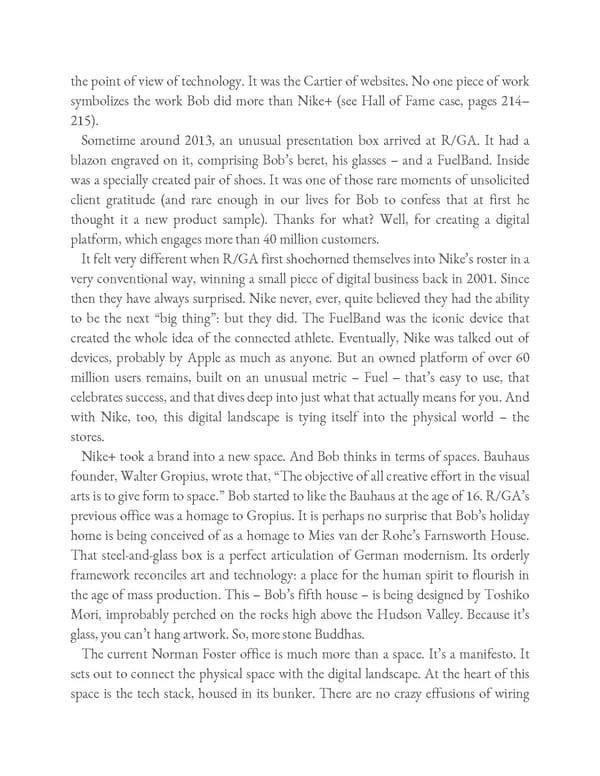the point of view of technology. It was the Cartier of websites. No one piece of work symbolizes the work Bob did more than Nike+ (see Hall of Fame case, pages 214– 215). Sometime around 2013, an unusual presentation box arrived at R/GA. It had a blazon engraved on it, comprising Bob’s beret, his glasses – and a FuelBand. Inside was a specially created pair of shoes. It was one of those rare moments of unsolicited client gratitude (and rare enough in our lives for Bob to confess that at first he thought it a new product sample). Thanks for what? Well, for creating a digital platform, which engages more than 40 million customers. It felt very different when R/GA first shoehorned themselves into Nike’s roster in a very conventional way, winning a small piece of digital business back in 2001. Since then they have always surprised. Nike never, ever, quite believed they had the ability to be the next “big thing”: but they did. The FuelBand was the iconic device that created the whole idea of the connected athlete. Eventually, Nike was talked out of devices, probably by Apple as much as anyone. But an owned platform of over 60 million users remains, built on an unusual metric – Fuel – that’s easy to use, that celebrates success, and that dives deep into just what that actually means for you. And with Nike, too, this digital landscape is tying itself into the physical world – the stores. Nike+ took a brand into a new space. And Bob thinks in terms of spaces. Bauhaus founder, Walter Gropius, wrote that, “The objective of all creative effort in the visual arts is to give form to space.” Bob started to like the Bauhaus at the age of 16. R/GA’s previous office was a homage to Gropius. It is perhaps no surprise that Bob’s holiday home is being conceived of as a homage to Mies van der Rohe’s Farnsworth House. That steel-and-glass box is a perfect articulation of German modernism. Its orderly framework reconciles art and technology: a place for the human spirit to flourish in the age of mass production. This – Bob’s fifth house – is being designed by Toshiko Mori, improbably perched on the rocks high above the Hudson Valley. Because it’s glass, you can’t hang artwork. So, more stone Buddhas. The current Norman Foster office is much more than a space. It’s a manifesto. It sets out to connect the physical space with the digital landscape. At the heart of this space is the tech stack, housed in its bunker. There are no crazy effusions of wiring
 Ogilvy on Advertising in the Digital Age Page 359 Page 361
Ogilvy on Advertising in the Digital Age Page 359 Page 361